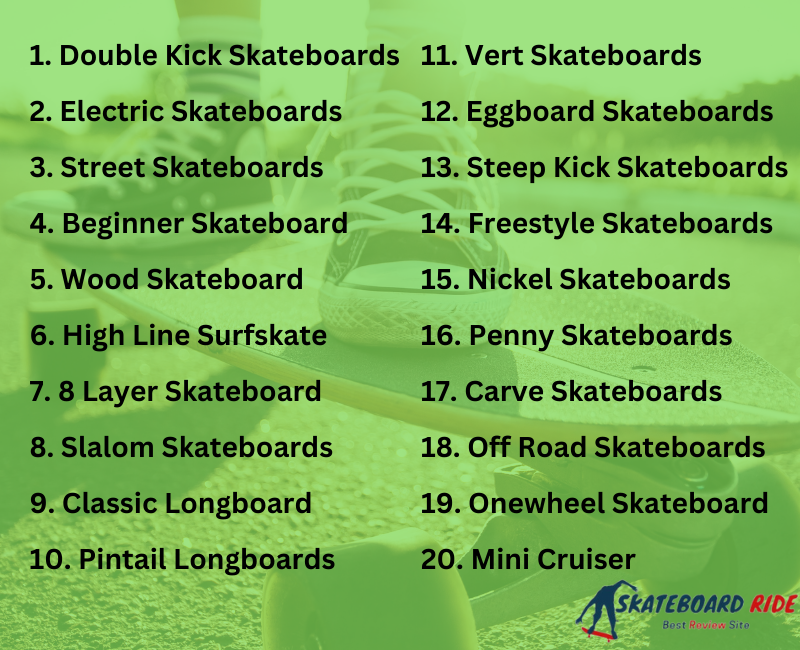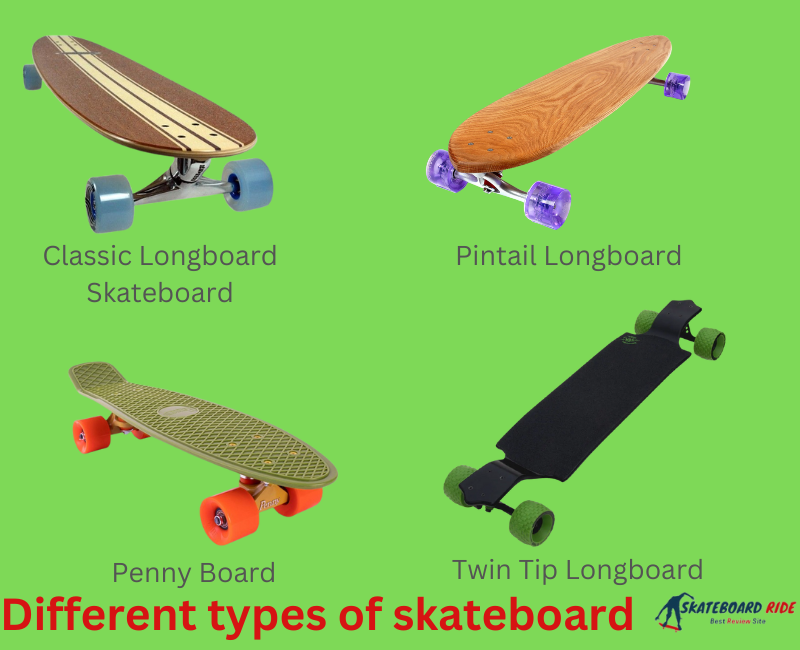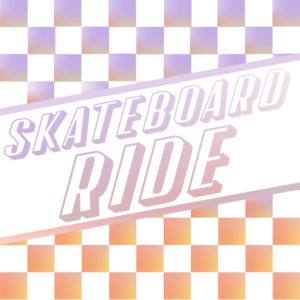Just admit it! You have decided that you would want to buy a skateboard for yourself, but you need help finding the appropriate type. So, selecting the right skateboard that can alleviate your concerns and anxieties should be a topic to which you give significant thought.
Because of its growing popularity, it has seen a great deal of transformation in terms of its appearance, structure, and shape. The following will serve as an introduction to the different types of skateboards that are now on the market.

Different Types of Skateboards
Skateboarding is a tough and dangerous activity. Skateboards come in a wide variety of shapes and sizes to accommodate the wide variety of skaters and conditions. Some are optimized for long-distance striding, while others are tops for stunts.
We’ll break down the various skateboard designs so you can choose the perfect one for your skating preferences.

- Double Kick Skateboards Or The Double-Kick Popsicle
It’s the most common skateboard. It’s great for skating at skate parks, cruising along the street, and pretty much any other kind of riding. They’re lightweight and ideal for skateboarding beginners.
Tricksters, grinders, curb shredders, and airborne skateboarders use the popsicle-shaped skateboard. It’s tail and nose kick and breadth curve are concave. Modern street decks are symmetrical and adaptable. This 1990s design uses seven layers of 1/16-inch hard maple veneer glued with PVA adhesive and pressed into a complicated shape.
- Electric Skateboards
Electric skateboards are the newest skateboard design. The paddle longboard, a pre-eSkate off-road deck with huge all-terrain wheels and a long flexible pole with a rubber ball at the end, was one of the earliest versions.
The model became a small-motorized electric skateboard. The design targets youthful urban commuters and techies. Motorized skateboards can go five miles at 15 mph. Simply moving the skateboard in a forward or reverse motion will engage the front and back brakes. Electric skates with a portable controller may accelerate and stop.
- Street Skateboards
Today, street skateboards shred park benches and leap stairs. Tony Hawk’s Pro Skater games likely popularized street skateboarding. However, not any skateboard will work in the concrete jungle. Setup is crucial. Start with deck size. A normal deck is 7′′-8′′.
Your board must be even and the right length. These boards are called “popsicle skateboards” because of their even distribution, like a popsicle stick. Street skateboard tricks need smaller wheels. Small wheels are slower because large wheels are faster. Street skateboards are designed to land tricks at high speeds.
- Beginner Skateboard
Skateboarding requires patience and practice. With the correct gear, it’s easy. Beginners should use a skateboard. These boards are more stable and broader. Skateboard wheels are also more strong than sleek. Balance and fewer wipeouts will ensue! To make learning to skate easier, pick a beginning skateboard.
- Wood Skateboard
Skateboards are made of several materials. Many have top covers for grip and traction. Others will feature wood grain designs that make them the best-looking boards on the market. After heavy usage, wood skateboards may often be refinished. Wood skateboards are distinctive for use or show.
- High Line Surfskate
Skateboarding was born from the similarities between surfing and skating. Many boards resemble surfboards and skateboards. Aggressive turns are easier with the High Line Surfskate. This skateboard is also durable and weatherproof. This one is for outside skating in any condition. The board is also shorter, making it simpler to transport.

- 8 Layer Skateboard
Skateboard makers will disagree on what makes the greatest skateboard. The eight-layer is fantastic for performance. Due to the materials used, these skateboards usually cost more. You may get a suitable skateboard from many manufacturers.
- Slalom Skateboards
Slalom skateboards are made for steep mountain terrain and racing. It’s a specialty skateboard that’s faster and more stable than a longboard. Skaters require cutaway fenders and a large wheelbase to safely bomb slopes at high speeds. Drop-through and conventional concaves are the major shapes.
- Classic Longboard Skateboards
Longboards are sturdy skateboards designed for boardwalk cruising, leisurely long-distance rides, and speeding over steep hills. They’re fantastic for beginners since their broad riding platform makes balancing simple.
They’re also perfect for all skaters. Most longboards are pintail or twin-tip. Longboards are 33 inches or longer. The skater may do wide-arched carves and twists on it. It was inspired by longboard surfboards from the 1950s and 1960s.
- Pintail Longboards
Debt shape affects performance. Pintail longboard decks improve cruising and carving. You can speed up, climb difficult slopes, and drive around town. Some skateboards have wheel bite.
Pintail longboards prevent wheels from hitting the deck. Hence the deck’s point. Pintail boards feature trucks in the front and rear and a unique deck form. This enhances riding flexibility. Pintail longboards are versatile and feel like surfboards.
- Vert Skateboards
Skating vert requires air. Vert skateboarders get more air on larger skate ramps. Steeper inclines increase speed. Vert skateboards have larger wheels and decks to prevent falls. Vert skateboarding elevates flip tricks. Skate parks provide vert ramps. Park skateboarding is rare, but vert ramps are exclusively seen at skate parks.
- Eggboard Skateboards
Eggboards are 9′′, the smallest mini boards. Eggboards are stable skateboards due to their width. Downhill skateboarding is possible with Eggboards due to their breadth. Eggboards are one of the most unusual small skateboards, but they feel the most complete. Your Eggboard may be carried about town in a backpack or beneath your desk.
- Steep Kick Skateboards
Skateboards with sharp kick tails “pop” while doing ground tricks. Steep kicks need more work to create a stronger explosion since they are higher. Thus, some skateboarders favor high-kick skateboards, while others prefer flatter boards. However, sharp kick tails let riders sense their board position at high speeds, making tricks easier. Pool skateboards need steep kicks.
- Freestyle Skateboards
Freestyle skateboards may look similar to street skateboards. However, freestyle skateboards are unique. Freestyle skateboards have flatter decks. A flatter board allows skaters to maneuver more freely. They’re not flat. Freestyle boards often include kick tails and double kicks.
Freestyle skaters put skid plates on the nose and tail. Many tricks require hopping and sliding on the board’s tips, therefore skid plates may protect you. Wheel size distinguishes freestyle skateboards from street skateboards. Freestyle boards have wider wheels with two bearings per wheel. Offset bearings prevent vehicles from ground contact.
Freestyle skateboarders flip their boards for several tricks. Thus, unlike other skating methods, the board touches the ground. Freestyle skateboards need these extra qualities.
- Nickel Skateboards
There’s a solution for plastic penny board fans who loathe their small size.
Nickel skateboard. Nickel boards are 27′′ tall, taller than pennies. All the characteristics of a penny are there, including a bigger frame, crazy colors, a plastic deck, and a waffle grip.
The extra length is affordable too. Nickel skateboards cost under $100. College campuses love nickel boards because of their inexpensive cost. Nickel boards are good for beginners who seek plastic skateboards.
- Penny Skateboards
The penny board moniker comes from the 1970s plastic skateboard’s rebirth. Penny Skateboards, a business founded in 2010, manufactured penny boards. The name became the board. The compact size and plastic technicolor boards distinguish penny boards. And by little, we mean 22″. Penny boards have waffle decks.
They’re rideable without grip assistance. These planks are thin and tiny. They’re unstable. Therefore, more dynamic skaters have the option of enhancing their grip with a penny configuration. Penny boards are still popular despite hardcore skaters’ disapproval.
- Carve Skateboards
Carve skateboard pumps effortlessly to produce speed. It mimicked the surfboard’s wave-face action on flat land. It’s a popular plank for riding bowls and practicing spins and deep carves. This hybrid skateboard design combines cruiser and longboard traits, making it popular.
- Off Road Skateboards
Do you enjoy skateboarding but live someplace without enough concrete and asphalt? Want to skateboard away from cities and cul-de-sacs? You may require an off-road skateboard. Off-road skateboards have huge wheels with thick tread to grasp various terrains. Off-road boards are wonderful for trails, dirt, grass, and BMX courses, but you can’t do skateboard tricks. You can always exchange wheels to street skate again. With little effort, you can skate two styles.
- Onewheel Skateboard
Onewheel skateboards are new. Onewheel electric skateboards are single-wheeled. This self-balancing skateboard’s mechanisms are unclear from afar. However, closer scrutiny makes it clear. The Onewheel board uses an electric motor to propel riders forward and backward. This means that the direction you lean in will be the direction the board propels you. Larger wheels eliminate balance. Onewheel skateboards provide a fresh design and an app to track journeys and establish riding preferences.
- Mini Cruiser Skateboards
Mini-cruisers are shorter cruiser skateboards. It’s ideal for beginners, but advanced skaters may use it to cruise about town, do tricks, ride a bowl, or visit a park. In the 2010s, they acquired popularity after being introduced early in the sport.
High school students love its compact, backpack-friendly design. Riders can do simple tricks and move about town on its soft wheels, kick tail, and textured surface. Plastic ones need special vehicles.
- Cruiser Skateboards
Cruiser skateboards are quite versatile. First, their decks are broader than others. They feature larger, softer wheels. Thus, those two qualities provide a really pleasant ride. Cruiser boards are perfect for city riding since they’re portable. They can easily take you there. Cruisers are great introductory skateboards. Cruiser boards help beginners balance and acquire confidence.
- Fishtail Skateboards
The fishtail skateboard is a popular choice for many skaters. By modifying the tail into a fish shape, you may significantly lessen the likelihood of wheel bite.
Width is another feature of a fishtail deck. When your board is broader, you’re better able to maintain your balance when you’re surfing. This implies that skaters have better heel and toe control while using a fishtail skateboard. A wide range of sizes, from longboards to cruisers, is available for fishtail skateboards.
- Double Drop Longboards
Lower skateboard decks boost speed and stability. Thus, downhill longboards with a low center of gravity are optimal. However, a low deck will touch the wheels. Hitting the wheels slows. Double-drop longboards fix it.
Double-drop longboards have taller noses and tails than the deck center. That extra drop lowers your center of gravity, making you more steady.
The twin drop technique is ideal for commuting because of its speed and steadiness. The best downhill longboard. Simply said, you need to reach where you’re going quickly and without colliding with anything.
- Twin Tip Longboards
Twin-tip longboards are great for cutting and speed. Twin-tip skateboards feature a broad center and almost similar tail and nose. Carve deep without wheel bite with a thin tail and nose. The large center stabilizes high speeds.

Twin tip boards install trucks through the deck. Unlike boards with trucks attached to the deck. Speed freaks will love twin-tip longboards.
Final Words
Each skateboard has benefits and downsides. Some enjoy cruisers, while others want fast skateboards. However, the skateboard you choose usually relies on your personality and intended use. Find a new board that matches your style. Spending a ton of money on shoes just to realize your board isn’t up to standard is the worst feeling in the world. Skateboards don’t fit everyone. Instead, evaluate your riding style and riding kind.
Recent Posts
Longboarding is an activity enjoyed by people of all ages. Whether you’re a beginner or a professional, it’s important to select the right longboard for your level of experience and riding style....
There's a lot of traffic at the airport, so skateboarding is a bit unusual. But if you think about it, airports make for perfect skateboarding terrain (oh....those smooooooth buttery concrete...
